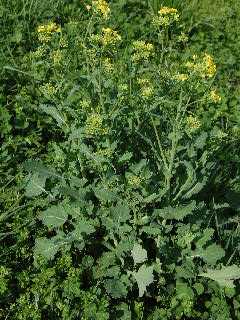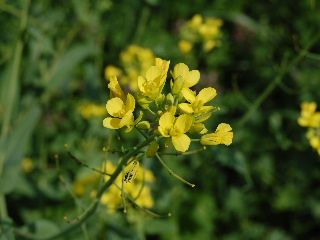
Growing up on the farm, we always thought of wild mustard as a weed, an unwelcome invader of the hayfield. We were encouraged to pull it up by the roots whenever we spotted it.
Now, I have a somewhat different view of this plant.
Wild mustard is a member of the brassica family that includes cabbage, turnips, and broccoli, as well as other edible leafy greens.
Wild mustard is an annual plant that reproduces only by seeds. Part of the rub in eliminating this plant from pasture fields or other crop fields where it isn’t wanted is that the mature dormant seeds have the ability to remain viable in the soil for many years (in some cases, up to 60 years!), before germinating and growing into new plants.
This means that the young plants have to be mechanically removed or eliminated with the use of chemicals before they reach seed-bearing age if the wild mustard is to be kept from ongoing encroachment in crop fields.
This is the dilemma facing the farmer or commercial crop producer. And, along these lines of thinking, wild mustard is still viewed as a weed and a problem.
But, let’s take another view of this plant. As we said, the brassica plants are leafy greens, many of which are edible and can be consumed safely by humans.
And, the green wild mustard leaves are a good source of Vitamins A, C, and D, as well as being a good source of fiber in the diet.
The leafy wild mustard greens can be prepared in your home kitchen pretty much the same way that you would prepare any other “store-bought” leafy greens such as turnip greens, kale, or collard greens—that is by first washing them to remove any dirt or debris, and then boiling them in clean water.
Wild mustard plants are most commonly found in soil that has been disturbed. So this can include any number of sites such as plowed fields intended for agricultural use or building sites that have been graded or altered in preparation for the construction of buildings.
Wild mustard is also often found along roadways whose banks have been mowed or graded.

So what does wild mustard look like? Well, if the wild mustard plants have already produced blooms, the plants are easily identified by the clusters of small bright yellow blossoms that have four symmetrical petals.
If you are seeking wild mustard in the pre-bloom stage, look for dark green unevenly jagged leaves on stems of the plants that can grow up to several feet in height.
The leaves are rather coarse and sometimes have a somewhat “hairy” texture too.
CAUTION: Absolutely never eat any plant harvested from the wild unless you are 110% sure of the identity of this plant and equally sure of its safety for human consumption!!
So, even though wild mustard is often considered an undesirable weed in the wild, it does have its place in the scheme of life. It’s a pretty wildflower, too!
 Growing up on the farm, we always thought of wild mustard as a weed, an unwelcome invader of the hayfield. We were encouraged to pull it up by the roots whenever we spotted it.
Growing up on the farm, we always thought of wild mustard as a weed, an unwelcome invader of the hayfield. We were encouraged to pull it up by the roots whenever we spotted it.
 So what does wild mustard look like? Well, if the wild mustard plants have already produced blooms, the plants are easily identified by the clusters of small bright yellow blossoms that have four symmetrical petals.
So what does wild mustard look like? Well, if the wild mustard plants have already produced blooms, the plants are easily identified by the clusters of small bright yellow blossoms that have four symmetrical petals.